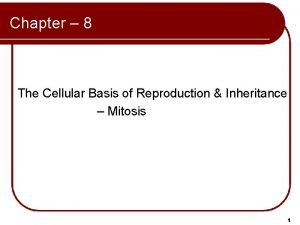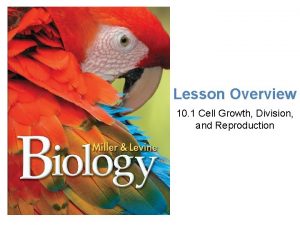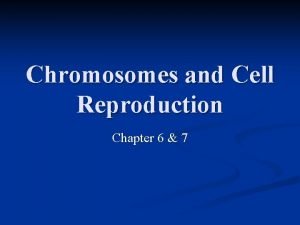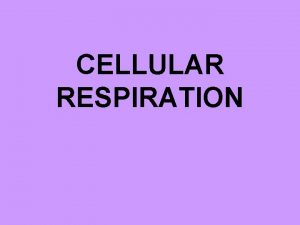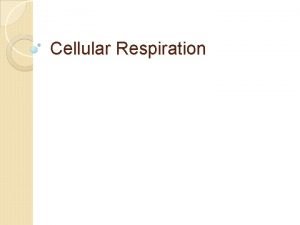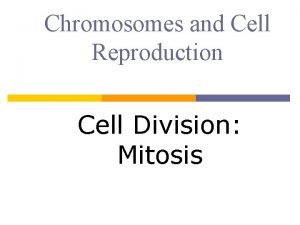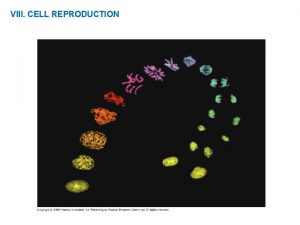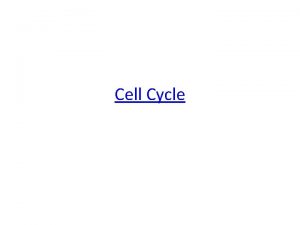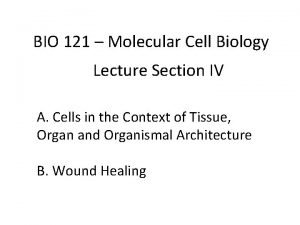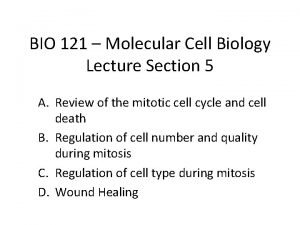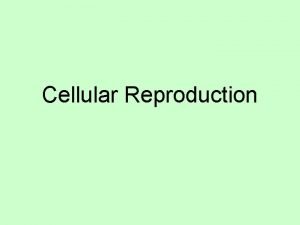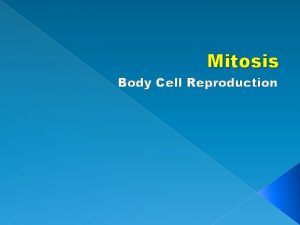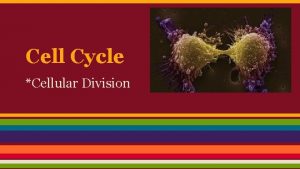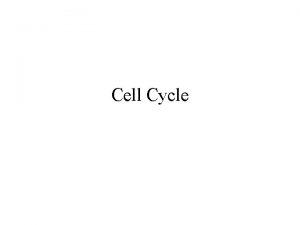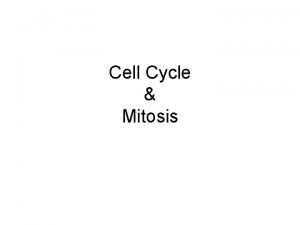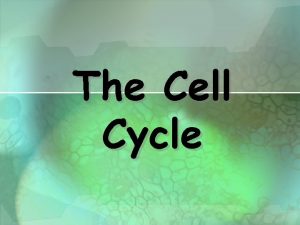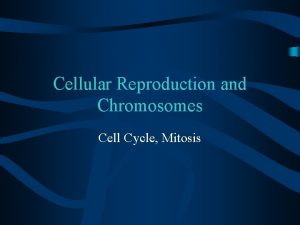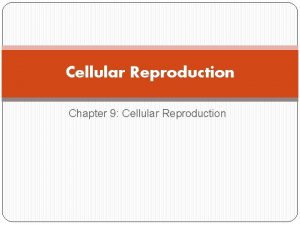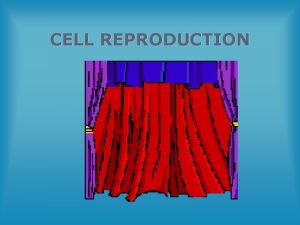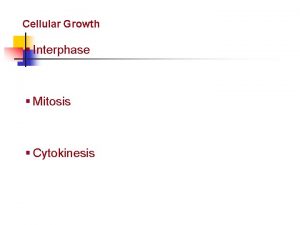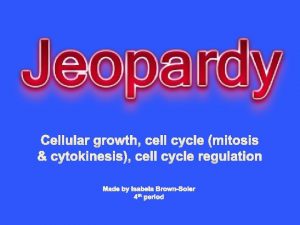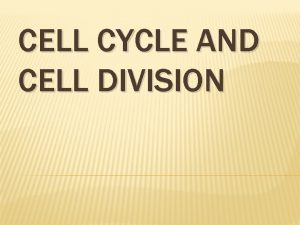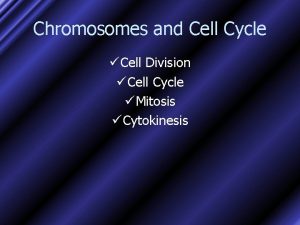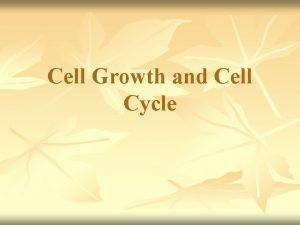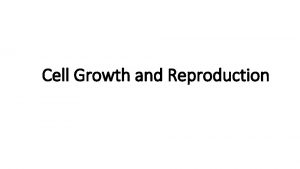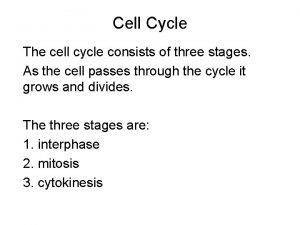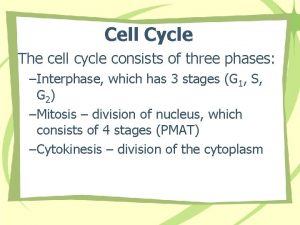The Cell Cycle and Cellular Reproduction Lecture Three






































- Slides: 38

The Cell Cycle and Cellular Reproduction Lecture Three Submitted by: Zied Jezawi

Ø The Cell Cycle Ø Mitosis and Cytokinesis Ø The Cell Cycle and Cancer Ø Prokaryotic Cell Division 2


Cell cycle Mitotic phase Cytokinesis Mitosis 4

Interphase 5

• Interphase consists of three stages: q. S q G 2 6

Occurs before DNA replication. • The cell increases in size, doubles its organelles and accumulates materials that will be used for DNA synthesis. 7

S Stage: § Occurs after G 1 stage. § DNA replication and synthesis. 8

G 2 Stage • Occurs after (S) stage • G 2 is the stage from the completion of DNA replication to the onset of mitosis. 9

M (Mitotic) Stage: • Following interphase, • This cell division stage includes mitosis (nuclear division) and cytokinesis (division of the cytoplasm). 10

Mitosis

Eukaryotic Chromosomes

• The somatic cells contain diploid chromosomes (2 n). • The gametes (egg, sperm) contain half quantity of chromosomes which called Haploid (1 n). 13

Phases of Mitosis 1. 2. 3. 4. 5. Prophase, Prometaphase, Metaphase, Anaphase, Telophase 14

The cell before mitosis 15

Prophase: • Chromatin has condensed and the chromosomes are visible. • The nucleolus start to disappears and the nuclear envelope fragments. 16

• In animal cells, an array of microtubules radiates toward the plasma membrane from the centrosomes 17

Prometaphase: Kinetochores appear on each side of the centromere to attach the chromatids to the spindle fibers. 18

Metaphase: Centromeres of duplicated chromosomes are arranged at the metaphase plate attached to the sister chromatids come from opposite spindle poles. 19

Anaphase: Sister chromatids part and become daughter chromosomes that move toward the spindle poles. 20

• In telophase: • The spindle disappears. • The nuclear envelopes form around the daughter chromosomes. A nucleolus appears in each daughter nucleus. 21

Interphase Prophase Telophase Anaphase Prometaphase Metaphase 22

�Cytokinesis is division of the cytoplasm. �Cytokinesis differs for plant and animal cell 23

In animal cells A cleavage furrow is formed and slowly a circular constriction appears between the two daughter cells.

25

Cytokinesis in Plant Cells • It involves the building of a cell plate between the daughter cells where a small, flattened disk appears between the two daughter plant cells. • The new cell plate known as primary cell walls, are later strengthened by the addition of cellulose fibrils. 26

Prokaryotic Cell Division • Cell division in unicellular organisms, such as prokaryotes, produces two new individuals. This is asexual reproduction. • The type of this asexual reproduction is called Binary fission ﺍﻻﻧﺸﻄﺎﺭ ﺍﻟﺜﻨﺎﺋﻲ

28



1 - Cell division in unicellular organisms results in ____ individuals. A) 4 B) 2 C) 1 D) 8 2 - Which best describes prokaryotes? A) Unicellular bacteria B) Prominent nucleus C) Many chloroplasts D) All of these 3 - Chromosomes are composed of _____. A) DNA only B) proteins only C) DNA and proteins 31

4 - Prokaryotes primarily reproduce _____. A) by binary fission B) sexually C) via meiosis 5 - If a cell with 46 chromosomes undergoes mitosis, the daughter cells will have _____ chromosomes. A) 23 B) 46 C) 92 6 - The region where sister chromatids are attached to one another is called the _____. A) centromere B) spindle C) aster D) centriole 32

7 - The _____ most likely provide(s) the material for spindle formation. A) nucleus B) cytoskeleton C) sister chromatids D) plasma membrane 8 - Which of the following is NOT associated with prophase? A) Fragmentation of the nuclear envelope B) Disappearance of the nucleolus C) Separation of the sister chromatids D) Visible chromosomes 9 - After _____ nuclear division is completed. A) prophase B) metaphase C) telophase D) interphase 33

10 - Alignment of the chromosomes at the equator of the spindle is characteristic of _____. A) metaphase B) prophase C) anaphase D) telophase 11 - Mistakes in the process of mitosis may result in _______. A) the duplication of chromosomes in cells B) the partial distribution of chromosomes C) the destruction of surrounding cells D) All of these 12 - The DNA is replicating during the ____ stage of the cell cycle. A) mitotic B) G 1 C) G 2 D) S 34

13 - New methods of cancer treatment prevent _____, which cuts off the supply of nutrients and oxygen to the tumor. A) metastasis B) angiogenesis C) differentiation D) anaplasia 14 - A disorganized, generally encapsulated mass that does not invade adjacent tissue is known as a _____. A) neoplasia B) benign tumor C) anaplasia 15 - Interphase consists of the _____ stages of cellular growth and division. A) G 1, G 2 and M B) G 1, S and G 2 C) M, S, and G 2 D) M, S and G 1 35

16 - The p 53 protein _____. A) inhibits repair enzymes B) stops the cell cycle during repair C) inhibits apoptosis D) All of the above 17 - Programmed cell death is known as _____. A) mitosis B) cytokinesis C) apoptosis 18 - When most cancers occur, _____ is absent or nonfunctional. A) the p 53 gene B) survivin C) angiogenesis 36

19 - If the diploid number of an organism is 30, the haploid number of the gametes is ______. A) 30 B) 60 C) 15 D) 10 20 - When mutations occur in proto-oncogenes, they become cancer causing agents called ______. A) tumor suppressor genes B) oncogenes C) stem cells D) haploid cells 37

Thank You 38
 Cellular transport and the cell cycle
Cellular transport and the cell cycle The cellular basis of reproduction and inheritance
The cellular basis of reproduction and inheritance Sexual reproduction and asexual reproduction
Sexual reproduction and asexual reproduction Chapter 9 cellular reproduction
Chapter 9 cellular reproduction Chapter 9 section 1 cellular growth
Chapter 9 section 1 cellular growth Chapter 9 cellular reproduction
Chapter 9 cellular reproduction Nondisjunction in meiosis
Nondisjunction in meiosis The disadvantages of sexual reproduction
The disadvantages of sexual reproduction Sexual and asexual reproduction in animals venn diagram
Sexual and asexual reproduction in animals venn diagram Section 10-2 cell division
Section 10-2 cell division Cell cycle and cell division
Cell cycle and cell division Cell cycle and cell division
Cell cycle and cell division Biology.arizona.edu/cell bio/activities/cell cycle/01.html
Biology.arizona.edu/cell bio/activities/cell cycle/01.html 01:640:244 lecture notes - lecture 15: plat, idah, farad
01:640:244 lecture notes - lecture 15: plat, idah, farad Cell growth division and reproduction
Cell growth division and reproduction Chapter 6 chromosomes and cell reproduction
Chapter 6 chromosomes and cell reproduction Spindle biology
Spindle biology All cells must contain
All cells must contain Where in the cell does cellular respiration occur
Where in the cell does cellular respiration occur Where in the cell does cellular respiration occur
Where in the cell does cellular respiration occur Cell reproduction
Cell reproduction Asexual reproduction cell division
Asexual reproduction cell division Cell of reproduction
Cell of reproduction Cell reproduction
Cell reproduction What are the net products of the krebs cycle
What are the net products of the krebs cycle Dense regular ct
Dense regular ct Fibroblast
Fibroblast Denuding tower
Denuding tower Prokaryotic cell and eukaryotic cell similarities
Prokaryotic cell and eukaryotic cell similarities Plant cell animal cell venn diagram
Plant cell animal cell venn diagram Plant cell structure
Plant cell structure Smooth er function
Smooth er function Primary and secondary cells
Primary and secondary cells Difference between plant cell and bacterial cell
Difference between plant cell and bacterial cell Prokaryotic cell and eukaryotic cell
Prokaryotic cell and eukaryotic cell Chapter 4 cell theory and cell study
Chapter 4 cell theory and cell study Idealized animal cell
Idealized animal cell Walker cell and hadley cell
Walker cell and hadley cell Plant cell animal cell venn diagram
Plant cell animal cell venn diagram

